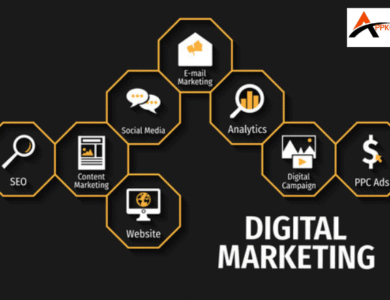
Marketing and advertising are often used interchangeably, but they are not the same. Marketing is a broad, strategic process that involves identifying customer needs and delivering value through products or services.
Advertising is a specific tactic within marketing that focuses on promoting a product or brand through paid channels. Understanding the distinction between the two helps businesses plan effectively, allocate budgets wisely, and reach their target audiences more efficiently.
This guide explores Marketing vs Advertising by highlighting 7 major differences, each explained in detail with examples.
Major Differences Between Marketing vs Advertising:
Now that we clearly understand what marketing and advertising mean and how they are connected, let’s look at the main differences between them.
Here are six key ways they are different.
1. Responsibilities
Marketing involves a wide range of responsibilities, including research, planning, development, branding, communication, and relationship management. It works at a strategic level to position the brand in the market.
Advertising is responsible for spreading promotional messages about a product or service. It’s tactical and focuses on immediate brand awareness or sales.
Marketing:
- Includes market research, brand strategy, product development, pricing, and distribution.
- Responsible for shaping the overall customer experience.
- Drives both pre-sales and post-sales activities.
Advertising:
- Handles the creation and delivery of promotional content.
- Focused on crafting messages and placing them in front of the right audience.
- Works as a tool to support marketing campaigns.
2. Purpose
The primary purpose of marketing is to build brand loyalty and long-term customer relationships. It aims at identifying target markets and ensuring satisfaction.
Advertising’s purpose is more direct it seeks to attract attention, increase visibility, and prompt immediate action or purchase.
Marketing:
- Aims to build long-term customer loyalty.
- Seeks to fulfill customer needs and create value.
- Focuses on market positioning and brand trust.
Advertising:
- Seeks to increase visibility and attract attention quickly.
- Encourages immediate actions such as purchases or inquiries.
- Primarily concerned with message reach and response.
3. Techniques Used
Marketing uses data-driven strategies such as customer segmentation, SEO, content creation, and analytics.
Advertising uses creative messaging through various channels such as TV, print, social media, and PPC to influence customer behavior.
Marketing:
- Email marketing, SEO, content strategy, influencer marketing, and CRM.
- Relies on customer feedback and behavioral data.
- Uses analytics to improve campaigns.
Advertising:
- Includes banner ads, social media ads, video ads, radio and TV commercials.
- Utilizes eye-catching visuals and slogans.
- Often leverages A/B testing and ad performance tools.
4. Investment Required
Marketing demands continuous investment across multiple areas like tools, personnel, research, and CRM systems.
Advertising often involves campaign-specific spending with higher costs, especially in mainstream or digital media.
Marketing:
- Requires ongoing investment in various areas: research, team development, tools.
- Budget may be spread over long-term strategies.
Advertising:
- High short-term investment, especially in paid campaigns.
- Costs vary based on platform and reach (TV, Google Ads, etc.).
5. Success Measurements
Marketing success is measured through long-term metrics like customer retention, brand loyalty, market share, and engagement.
Advertising is evaluated by short-term KPIs such as impressions, clicks, conversions, and ROI on individual campaigns.
Marketing:
- Measures include brand equity, customer retention, market penetration.
- Focuses on metrics like CLV (Customer Lifetime Value) and engagement rates.
Advertising:
- Measured using metrics like CTR (Click Through Rate), impressions, and conversions.
- ROI is calculated for specific campaigns.
6. Duration and Focus
Marketing strategies evolve over time and require consistent effort. It focuses on building reputation, value, and trust.
Advertising is often time-bound and designed for quick outcomes, with a primary focus on visibility and lead generation.
Marketing:
- Works on a long-term vision.
- Focuses on brand positioning, customer relationships, and loyalty.
Advertising:
- Typically short-term and campaign-based.
- Centered around product launches, offers, or seasonal promotions.
7. Role in Business Strategy
Marketing shapes the overall direction of a company’s customer strategy. It plays a key role in product decisions, pricing, and market positioning.
Advertising supports these strategies by broadcasting the right messages to target audiences in a compelling way.
Marketing:
- Directly tied to company growth and market share.
- Informs decisions on pricing, product lines, and customer service.
Advertising:
- Plays a supportive role by communicating the value proposition.
- Translates marketing goals into promotional campaigns.
Marketing Overview Key Points
Marketing is the umbrella function that encompasses multiple aspects of customer engagement.
- Long-term and strategy-focused
- Involves research, branding, pricing, and communication
- Builds and maintains customer relationships
- Influences every stage of the customer journey
Advertising Overview Key Points
Advertising is a subset of marketing, focused purely on promotional communication.
- Short-term and campaign-based
- Delivers targeted messages to large audiences
- Relies on paid media and platforms
- Drives awareness, interest, and conversions
Conclusion:
Marketing and advertising serve different but complementary roles in business growth. Marketing sets the strategy, while advertising executes it. Understanding the distinctions helps organization balance their efforts and achieve better results across the customer journey.



